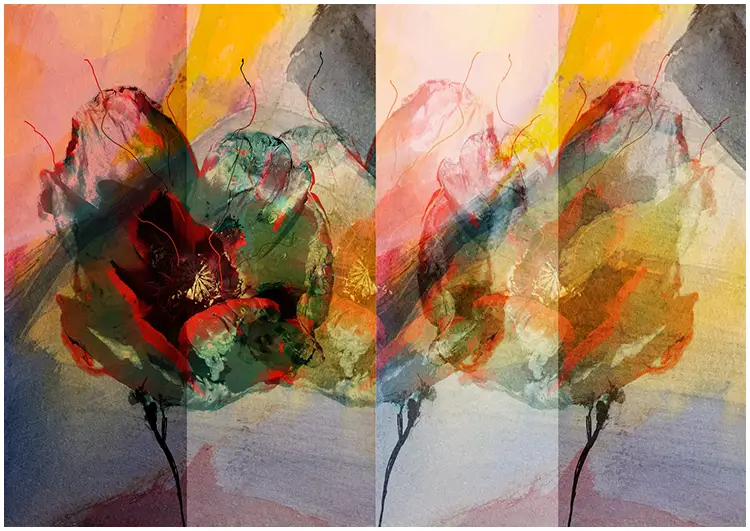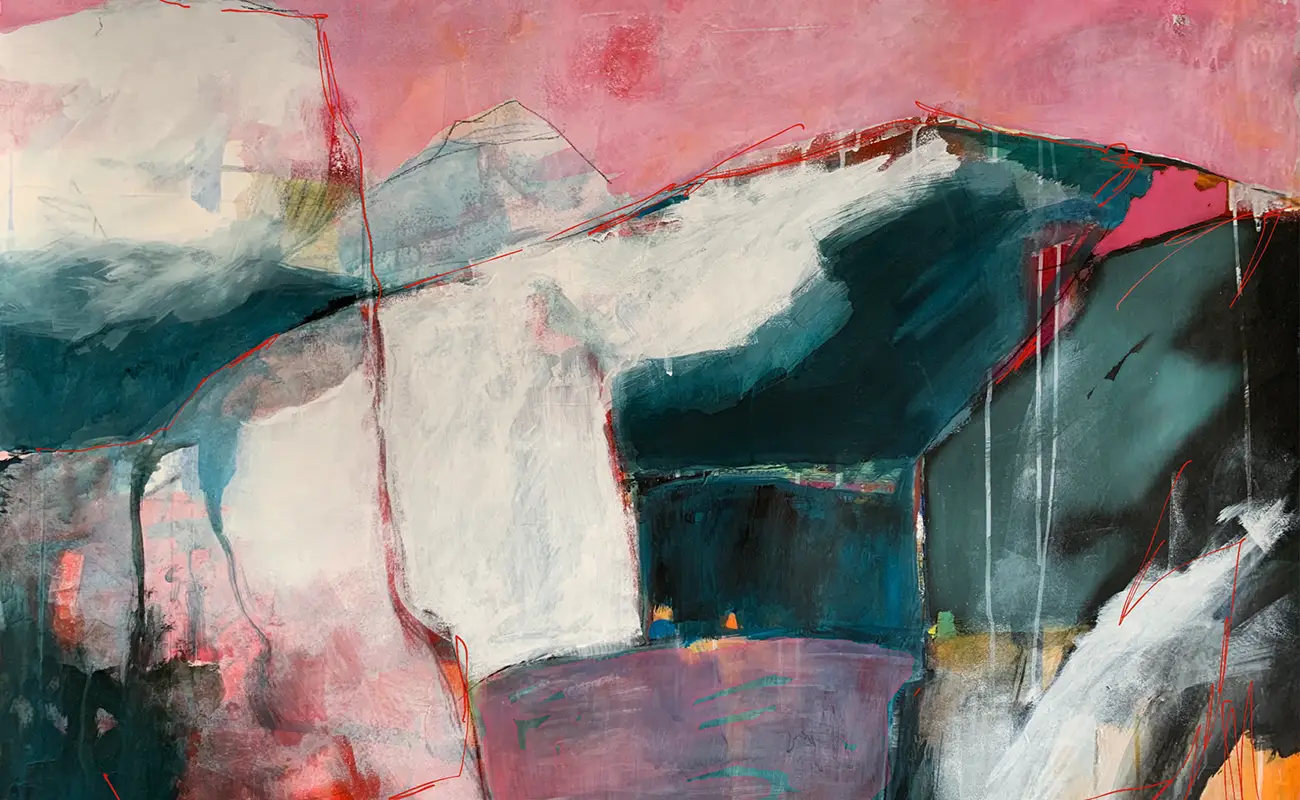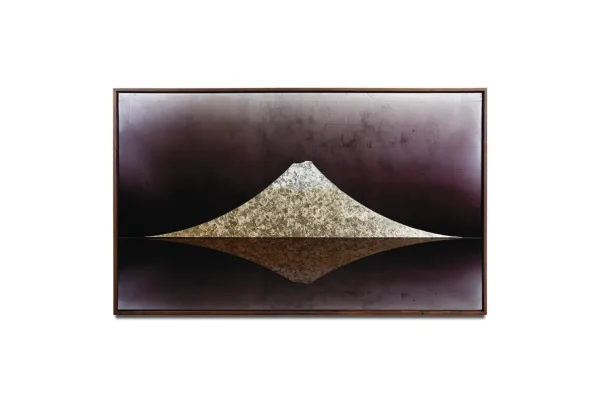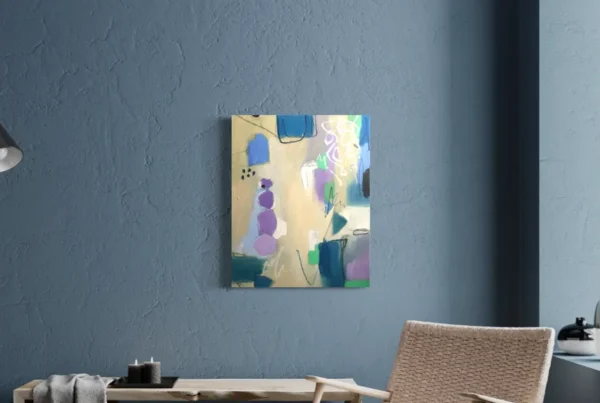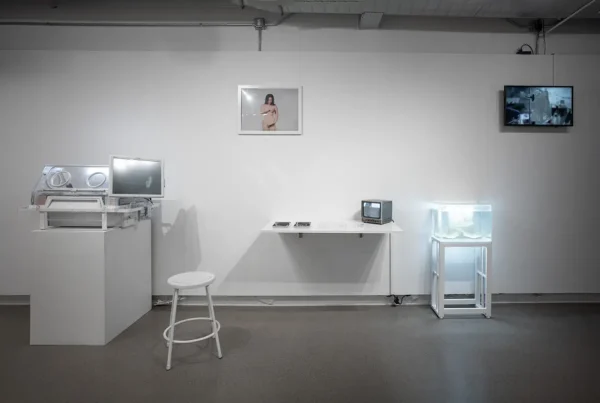“I call it The Inventory of the World: the impossible ambition to paint every person I meet, every mountain I see, and every flower I encounter.”
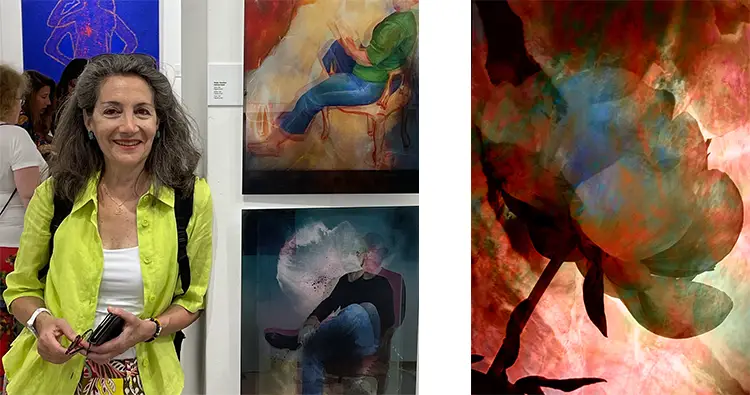
Between Childhood and Exile : The Birth of an Artist
Nada Stauber’s trajectory into the art world began not in a studio but amid the business bustle of Beirut, where she was born into a family more acquainted with jewelry than sketchbooks. Her father’s newly launched career as a jeweler consumed much of her parents’ time, though they remained committed to her education. It was a nun at school who first recognized Nada’s precocious talent. Impressed by her early drawings, the nun urged her mother to supply her with colored pencils and a notebook—a small gesture that opened the door to a lifelong artistic pursuit. From that moment, visual creation became her primary language, long before writing ever did.
As civil war crept into Lebanon during her teenage years, the conflict’s forced isolation paradoxically nurtured her creativity. Confined indoors, she filled the silence with stories told in drawings and comic strips, exploring narratives both real and imagined. Despite her schooling’s emphasis on the sciences, Nada never wavered in her artistic ambition. At eighteen, she made the pivotal decision to enroll in the École des Beaux-Arts in Lausanne, Switzerland—now ECAL—where she pursued Graphic Design. Her time there introduced her to the influential teachings of figures like Werner Jeker and Jean Otth, whose insights into design and video art profoundly shaped her rigorous yet audacious approach to image-making, along with a deep commitment to creative excellence.
Although ECAL exposed her to a broad spectrum of creative practices, including sculpture and photography, Nada’s commitment to drawing remained steadfast. The act of drawing was never just about representation; it was about constructing visual spaces that reached far beyond the surface and told stories. That foundation in structured design, combined with a love for expressiveness, would come to define her evolution from graphic designer to painter, from illustrator to digital explorer.

Nada Stauber: Intuition, Impact, and Expressiveness
The early phases of Nada’s professional life followed a natural progression from her design education. Surrounded by a network of artists and creatives, she ventured into freelancing as both an illustrator and graphic designer. These projects often provided her with opportunities to integrate her own painted elements into commissioned works, creating a seamless overlap between client-driven assignments and her independent artistic voice. As she transitioned into motherhood—eventually raising four boys—her priorities and artistic methods shifted accordingly. Painting, as a technique that offers greater freedom, became her primary medium to express her voice during this period.
In parallel with her canvas work, she also began crafting papier mâché figures inspired by her children. These lively sculptural pieces cohabited with her paintings in her first installation works, allowing her to build immersive and animated environments. These mixed-media works marked her entrance into the gallery and museum world, gaining attention for their originality and emotional resonance. However, a significant health issue later compelled her to stop working with papier mâché, leading her to concentrate exclusively on painting. Since then, Nada has continued to exhibit widely in European galleries, refining a style that is recognizably hers—vivid, energetic, and graphically potent.
Nada resists the idea that her work is autobiographical or emotionally confessional. Instead she strives to create pieces that feel graphically ‘right’, or accurate—meaning well-balanced and expressive—to elicit visual resonance from viewers. Her paintings are often direct and immediate, executed without preparatory sketches. Corrections emerge organically through layering, often using acrylics along with charcoal and ink. Her bold, unfiltered gestures give rise to what a journalist once coined “Expressionist 2.0”—a label that captures the dynamic tension between figuration and abstraction in her work. Subject matter, whether floral, human, or mountainous, serves less as a focal point and more as a pretext for formal and technical experimentation. Yet the theme of the mountain remains close to her heart, as it allows her, through metaphor, to recount a part of her family’s history and its many exiles. Through vibrant contrasts and exaggerated forms, she constructs visual spaces charged with energy and intensity.
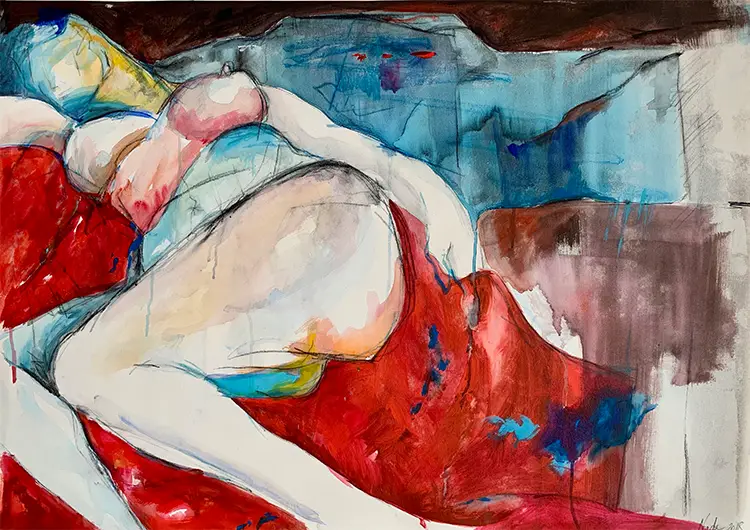
Art and Alchemy: The Potential of Hybridity
With over four decades of artistic exploration behind her, Nada refuses to be confined by stylistic boundaries. Though figurative work has been central to her practice, her approach is far from rigid. Painting quickly and instinctively, she often allows the work to find its shape in the act of creation, occasionally tending toward abstraction. This improvisational technique serves her expressive objectives well. Her brushwork is forceful, often textured by the interplay between bold colors and stark outlines. Whether she’s painting a landscape or a single flower, Nada approaches each subject as an opportunity to distill emotion into image, stripping away representational fidelity in favor of visual power.
In recent years, she has ventured into the realm of digital experimentation—particularly intrigued by the fusion of photography and painting. This shift was deeply influenced by her encounter with David Hockney’s iPad works, which revealed a new dimension of creative freedom. What began as a playful use of earlier paintings transformed into a more thoughtful process involving the layering of digital and analog techniques. This technical alchemy produces hybrid images, such as those featured in her “Nouvelles images” that gain depth and a poetic dimension. It adds an element of intentional ambiguity, as viewers are often unsure what medium they are looking at. This uncertainty invites closer attention, and blurs the boundaries between the physical and the digital, the painted and the photographed.
This digital-traditional new vocabulary opens doors to unpredictable images, subtle textures, and elusive atmospheres that might be inaccessible through conventional painting alone. She approaches this complex process with the same sense of discipline she honed during her graphic design training, ensuring that the resulting images maintain structural cohesion and visual impact. Despite the endless creative possibilities offered by digital tools, Nada insists on staying present and in control during image development. For her, visual resonance comes not from chaos, but from clarity and harmony.
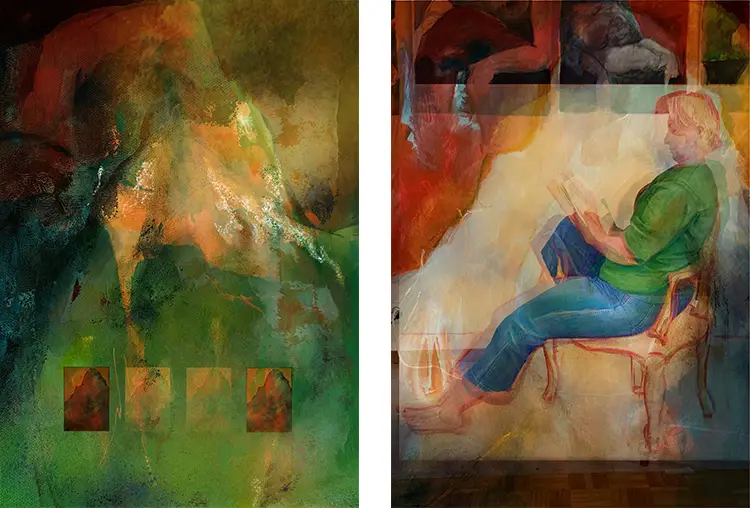
Nada Stauber: Painting the Unfinishable Vision
One of Nada’s most cherished concepts—a personal and philosophical cornerstone of her work—is what she refers to as The Inventory of the World. It is an ambitious, open-ended dream: to paint every person she meets, every mountain she encounters, every flower she observes. While she acknowledges the impossibility of such a project, the aspiration itself continues to animate her practice. This vision mirrors the archival impulse of Gerhard Richter’s Atlas, a collection built on the desire to record, classify, and embrace the world through visual language. Nada’s interpretation, however, is more poetic than systematic. For her, each painting is a moment of contact with the world, a small contribution to an infinite narrative of presence and observation.
Although Nada has worked across a wide variety of media—including oil, watercolor, and monoprinting—her current passion lies in the synthesis of digital tools with painting and photography. Over the last five years, this triad has dominated her practice. Digital painting, in particular, has allowed her to manipulate and recompose existing works, effectively creating new images from familiar elements. What began as playful recombination has matured into a refined and coherent methodology, marked by both freedom and constraint. Each hybrid piece is built through a combination of spontaneity and editorial discernment.
But if her techniques evolve, her way of entering the work remains deeply rooted in ritual. Each studio session begins with a quiet preparation of the space—opening the windows, putting on music, and pausing to observe recent pieces pinned to the wall. Often, she loosens her hand with a few spontaneous doodles on large sheets of paper, an instinctive gesture that helps unlock a sense of flow. From there, she enters a meditative state: focused yet spacious, alert yet detached. As she paints, it is as if the work begins to lead the way, revealing itself gradually through accumulated gestures and intuitive choices.
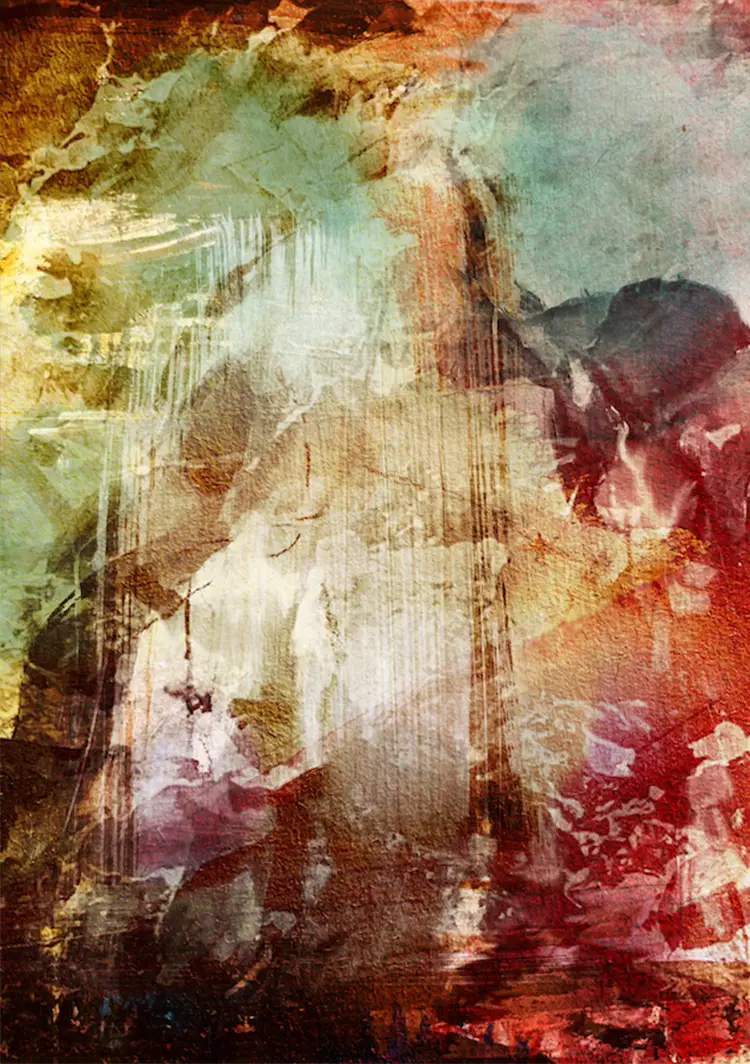
Among her works, Montagne 314 is a striking composition in which fiery reds and shadowed browns collide and dissolve across the canvas, evoking not a literal mountain but the memory of one. Its forms appear both monumental and precarious, suspended between solidity and collapse. Through layered paint and gestural linework, the piece evokes a sense of exile and return—not as narrative, but as atmosphere. In this work, the mountain transcends its role as subject; it becomes a vessel of lived history, emotion, and shifting identity—shaped and reshaped through the accumulation of time, memory, and the movement of the brush.
In this space between the seen and the felt, between observation and improvisation, Nada Stauber continues to build her visual inventory. Not to catalogue the world, but to remain in dialogue with it—one image at a time.
